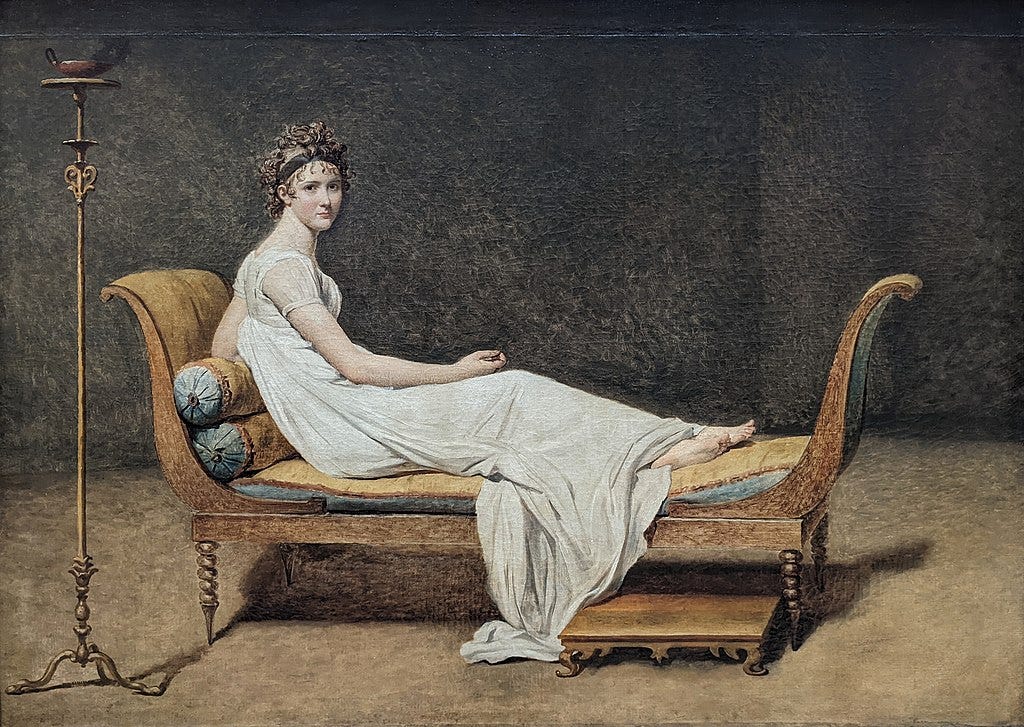The neoclassical masterpiece ‘Portrait of Juliette Récamier’ by François Gérard (1802-1805) is a celebrated work of art that captures the beauty, poise, and cultural significance of its subject. It is not just a testament to Gérard’s artistic brilliance but also a window into the remarkable life of Juliette Récamier, one of early 19th-century France’s most iconic figures.
Who Was Juliette Récamier?
Juliette Récamier (1777-1849) was a celebrated socialite whose salons and influence resonated throughout Parisian society. Renowned for her beauty, grace, and intelligence, Juliette became a central figure in cultural and political circles.
Juliette was married at just 15 to Jacques-Rose Récamier, a wealthy banker and supposedly her biological father. The union was reportedly platonic and would have only been done to ensure inheritance to Juliette.
By 1797, the young woman began hosting a Parisian salon that quickly gained fame as a hub for intellectual and cultural exchange. Writers, politicians, and artists, including luminaries like Madame de Staël, Benjamin Constant, Chateaubriand, and Lamartine, frequented her gatherings, drawn by her charm and wit.
Juliette’s reputation extended beyond her salons. She was considered one of the “Three Graces” of the Directoire era (1795-1799), alongside Joséphine de Beauharnais (Napoléon’s wife) and Madame Tallien. Her fashion sense, favoring Greek-inspired gowns and neoclassical décor, set trends among the Parisian elite.
Composition
François Gérard’s depiction of Juliette Récamier reflects the neoclassical style’s elegance and simplicity. She is portrayed in a flowing white gown inspired by ancient Greek attire, complemented by a brightly colored shawl. The composition highlights her delicate features and serene demeanor, qualities that earned widespread admiration during her lifetime.
This painting was commissioned whereas Jacques-Louis David began a portrait of Madame Récamier in 1800. The painter deliberately left it unfinished, when he learned that François Gérard - his former student - had also been commissioned to make a portrait of the same model.
Gérard’s version, with its polished execution and flattering portrayal, was preferred by Juliette and remains one of his finest works. The attention to detail and refined aesthetic underscore both her beauty and her stature in society.
Her posture, with her face directly addressing the viewer with a down-turned, sweet smile, is also creating a more engaging and intimate atmosphere than David’s rigid composition.
The Legacy of Juliette Récamier and the Painting
The ‘Portrait of Juliette Récamier’ was widely reproduced through engravings, solidifying its status as an iconic representation of its subject. It not only immortalized Juliette but also reinforced her position as a cultural and intellectual symbol of her time.
Her life, however, was not without challenges. Juliette faced exile by Napoleon Bonaparte due to her association with political opponents, notably Madame de Staël. Following Napoleon’s abdication in 1814, she returned to Paris and resumed her salon activities, which shifted towards literature and culture.
Juliette Récamier’s influence endured long after her death on May 11, 1849, at the age of 71. She remains a muse and an emblem of neoclassical beauty and intellect. Gérard’s portrait stands as a lasting tribute to her legacy, a masterpiece that captures the essence of a woman who epitomized elegance and influence in an era of profound cultural transformation.
Last proof of its importance, the portrait is today exhibited at the Carnavalet Museum, which traces the history of Paris.






